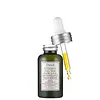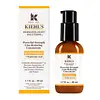What's inside
What's inside
 Key Ingredients
Key Ingredients

 Benefits
Benefits

 Concerns
Concerns

 Ingredients Side-by-side
Ingredients Side-by-side

Water
Skin ConditioningIsononyl Isononanoate
EmollientGlycerin
HumectantPentylene Glycol
Skin ConditioningPropanediol
SolventCocos Nucifera Oil
MaskingZingiber Officinale Water
MaskingPolymnia Sonchifolia Root Juice
Skin ConditioningCichorium Intybus Root Extract
MaskingVaccinium Myrtillus Fruit Extract
Skin ConditioningHelianthus Annuus Seed Oil
EmollientSaccharum Officinarum Extract
MoisturisingCitrus Aurantium Dulcis Fruit Extract
MaskingCitrus Limon Fruit Extract
MaskingAcer Saccharum Extract
Skin ConditioningTocopheryl Acetate
AntioxidantAscorbyl Tetraisopalmitate
AntioxidantTocopherol
AntioxidantCarbomer
Emulsion StabilisingParfum
MaskingSodium Hydroxide
BufferingDisodium EDTA
Alcaligenes Polysaccharides
EmollientAmodimethicone
Panthenol
Skin ConditioningMagnesium Aspartate
Skin ConditioningZinc Gluconate
Skin ConditioningEthylhexylglycerin
Skin ConditioningBeta-Carotene
Skin ConditioningCopper Gluconate
Skin ConditioningChlorphenesin
AntimicrobialPotassium Sorbate
PreservativePhenoxyethanol
PreservativeLimonene
PerfumingLinalool
PerfumingCitral
PerfumingBenzyl Salicylate
PerfumingWater, Isononyl Isononanoate, Glycerin, Pentylene Glycol, Propanediol, Cocos Nucifera Oil, Zingiber Officinale Water, Polymnia Sonchifolia Root Juice, Cichorium Intybus Root Extract, Vaccinium Myrtillus Fruit Extract, Helianthus Annuus Seed Oil, Saccharum Officinarum Extract, Citrus Aurantium Dulcis Fruit Extract, Citrus Limon Fruit Extract, Acer Saccharum Extract, Tocopheryl Acetate, Ascorbyl Tetraisopalmitate, Tocopherol, Carbomer, Parfum, Sodium Hydroxide, Disodium EDTA, Alcaligenes Polysaccharides, Amodimethicone, Panthenol, Magnesium Aspartate, Zinc Gluconate, Ethylhexylglycerin, Beta-Carotene, Copper Gluconate, Chlorphenesin, Potassium Sorbate, Phenoxyethanol, Limonene, Linalool, Citral, Benzyl Salicylate
Propylene Glycol
HumectantDimethicone
EmollientGlycerin
HumectantAscorbic Acid
AntioxidantEthylhexyl Palmitate
EmollientCetyl PEG/PPG-10/1 Dimethicone
EmulsifyingDimethicone Crosspolymer
Emulsion StabilisingAscorbyl Glucoside
AntioxidantCyclohexasiloxane
EmollientHydroxyethylpiperazine Ethane Sulfonic Acid
BufferingLauroyl Lysine
Skin ConditioningAcrylonitrile/Methyl Methacrylate/Vinylidene Chloride Copolymer
Polysilicone-11
Adenosine
Skin ConditioningHydrolyzed Hyaluronic Acid
HumectantLimonene
PerfumingIsobutane
Citrus Aurantium Dulcis Peel Oil
MaskingCitrus Limon Peel Oil
MaskingCitral
PerfumingPentaerythrityl Tetra-Di-T-Butyl Hydroxyhydrocinnamate
AntioxidantPropylene Glycol, Dimethicone, Glycerin, Ascorbic Acid, Ethylhexyl Palmitate, Cetyl PEG/PPG-10/1 Dimethicone, Dimethicone Crosspolymer, Ascorbyl Glucoside, Cyclohexasiloxane, Hydroxyethylpiperazine Ethane Sulfonic Acid, Lauroyl Lysine, Acrylonitrile/Methyl Methacrylate/Vinylidene Chloride Copolymer, Polysilicone-11, Adenosine, Hydrolyzed Hyaluronic Acid, Limonene, Isobutane, Citrus Aurantium Dulcis Peel Oil, Citrus Limon Peel Oil, Citral, Pentaerythrityl Tetra-Di-T-Butyl Hydroxyhydrocinnamate
 Reviews
Reviews

Ingredients Explained
These ingredients are found in both products.
Ingredients higher up in an ingredient list are typically present in a larger amount.
Citral is a fragrance and used to add a lemon-like scent to products. It is both naturally found in plants and created synthetically. In plants, it is commonly occurring in lemon myrtle, lemongrass, lemon tea-tree, lemon verbena, and other citruses.
The EU mandates Citral be listed separately as a fragrance. It is a known allergen and may cause contact dermatitis. Citral can also used as a masking ingredient.
The term 'fragrance' is not regulated in many countries. In many cases, it is up to the brand to define this term. For instance, many brands choose to label themselves as "fragrance-free" because they are not using synthetic fragrances. However, their products may still contain ingredients such as essential oils that are considered a fragrance.
The term 'citral' is a collective term for two geometric isomers: geranial/Citral A and neral/Citral B.
Learn more about CitralGlycerin is already naturally found in your skin. It helps moisturize and protect your skin.
A study from 2016 found glycerin to be more effective as a humectant than AHAs and hyaluronic acid.
As a humectant, it helps the skin stay hydrated by pulling moisture to your skin. The low molecular weight of glycerin allows it to pull moisture into the deeper layers of your skin.
Hydrated skin improves your skin barrier; Your skin barrier helps protect against irritants and bacteria.
Glycerin has also been found to have antimicrobial and antiviral properties. Due to these properties, glycerin is often used in wound and burn treatments.
In cosmetics, glycerin is usually derived from plants such as soybean or palm. However, it can also be sourced from animals, such as tallow or animal fat.
This ingredient is organic, colorless, odorless, and non-toxic.
Glycerin is the name for this ingredient in American English. British English uses Glycerol/Glycerine.
Learn more about GlycerinLimonene is a fragrance that adds scent and taste to a formulation.
It's found in the peel oil of citrus fruits and other plants such as lavender and eucalyptus. The scent of limonene is generally described as "sweet citrus".
Limonene acts as an antioxidant, meaning it helps neutralize free radicals.
When exposed to air, oxidized limonene may sensitize the skin. Because of this, limonene is often avoided by people with sensitive skin.
The term 'fragrance' is not regulated in many countries. In many cases, it is up to the brand to define this term. For instance, many brands choose to label themselves as "fragrance-free" because they are not using synthetic fragrances. However, their products may still contain ingredients such as essential oils that are considered a fragrance.
Learn more about Limonene